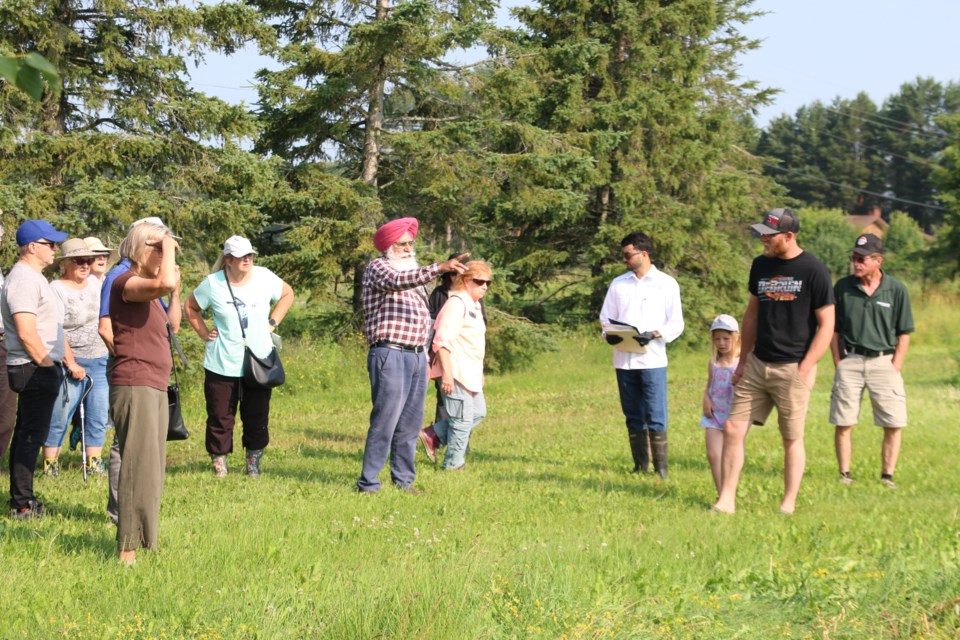THUNDER BAY — The Lakehead University Agricultural Research Station showcased 44 experiments and other projects it's doing this year to local producers at its annual summer tour day.
Most notably, the station is adding 31 new varieties of all its crops to avoid stagnancy to sustain and improve crop yields, testing the greenhouse gas emissions of different enhanced-efficiency fertilizers and assessing whether these fertilizers could improve the efficiency of fertilizer use.
“Even before I start seeding the experiments, I share what sort of experiments I’m going to do with farmers and ask them if there’s anything else they would like us to do,” said Tarlok Singh Sahota, the station’s director, who personally meets with farmers in their fields and barns for these discussions.
“So, this is a very shared program with the farmers and (the) farm will be closely linked with the farmers. I think this is probably the only substation in our country, not only in the province, that works so closely with the farmers. We don’t keep anything with us ... everything we share.”
Carole McCollum was invited to participate in the educational tour alongside other members of the Thunder Bay and District Master Gardeners for the first time. She said the group had hoped to visit the station last year.
“We’re not really into farming, but it’s nice to know about the different crops that are available in Thunder Bay,” said McCollum.
McCollum said they also hoped to learn about the various crops and how the station conducts experiments, grows and tries all the different varieties of plants.
“Hopefully, we’ll learn something that we can pass on to somebody,” said McCollum.
The educational group often stops at horticultural events, the Thunder Bay Art Gallery and garden tours to answer people’s questions about gardening, different plants, diseases and garden problems.
“We often get questions when we’re out at various events about crops to grow, various vegetables (and) various farm items,” said McCollum.
“So, we’re hoping to be able to answer those questions and it’s nice to have scientific answers rather than just general answers for people.”
Crop production depends on three factors, Sahota said. These factors include the plants' genetic potential for producing high or low yields, as well as nutrient management and weather conditions. With only the first two factors within the station’s control, it works to manage them.
“To get better yield from the high-yielding varieties, or better yield, we have to have proper nutrient management. They have to be fed properly in balanced amounts of nutrients so that we get better yield,” Sahota said.
The station also tested bioproducts such as Holganix, which claims to reduce crops’ fertilizer requirements, increase yield, improve crop resilience against stress and boost soil health by harnessing over 800 microorganisms.
Microorganisms continually work in the soil, Sahota explained, and transform nutrients from their non-available form to a plant-available form.
He said they can improve soil health because “soil is a living system.”
“We are testing its effects on canola, on the (nitrogen) requirements and (phosphorus) requirements, whether it’s really able to lower the nutrient requirement(s). If it does, it will be economical for farmers to grow the crops,” Sahota said.
In addition, the station tested seeding canola, a cold-loving crop, at different weekly intervals from May 12 to June 23 to determine the best time or cutoff date for seeding.
“The earlier seeding might make good growth (and) better growth than late seeding and it might need more nutrients than the late seeding crop, which will be poor in growth,” Sahota said.
“So then we have to standardize for each timing what is the optimum rate of fertilizer, so the farmer does not apply more nutrients … when it is not required," he said.
With seasonal droughts over the last three to four years, the research station also attempted to increase drought resistance in crops — one way being the application of more potassium, an essential plant nutrient.
Aligning with these efforts, it also tested a new crop called pearl millet, an annual forage crop, which originates from warmer and tropical areas.
“With the weather warming up, we need to test crops and crop varieties from the warm areas (to see) if they are suited here,” Sahota said.
While all the data and results gathered at the research station are first compiled into its annual report, which is shared with farmers, other local stakeholders and ministry specialists, Sahota also occasionally writes educational articles.
Sahota thanked the provincial and federal governments for funding the program through the Sustainable Canadian Agricultural Partnership (SCAP) program.
“Whatever technology we produce, it goes free to farmers — we don’t charge anything," Sahota said, adding that the station would not exist without government funding.
"So, there is no income as such from the technology we generate at the substation, so funding is very important.”
